UNIT 5: POLITICAL SYSTEMS AND THE WORLD TODAY
| Site: | MoodleHUB.ca 🍁 |
| Course: | Social 30-1 RVS |
| Book: | UNIT 5: POLITICAL SYSTEMS AND THE WORLD TODAY |
| Printed by: | Guest user |
| Date: | Thursday, 6 November 2025, 1:27 AM |
Table of contents
- 1. OVERVIEW: POLITICAL SYSTEMS
- 2. CONCEPTS AND TERMS
- 3. Power and Decision Making
- 4. Historical Perspectives
- 5. Power and Decision Making in Aboriginal Socities
- 6. Imposition of Liberalism
- 7. Failures of Liberalism
- 8. Liberal Democratic Systems
- 9. The Will of the People
- 10. Direct and Representative Democracies
- 11. Canada's Parliamentary Democracy
- 12. Presedential Rebpulican Democracy
- 13. Proportional Representation
- 14. Influences and Challenges to Decision Making
- 15. QUIZ 5.1: POLITICAL SYSTEMS
- 16. Intro to Authoritarian Systems
- 17. Ideologies and Authoritarianism
- 18. Types of Authoritarianism
- 19. Techniques of Authoritarianism
- 20. Authoritarianism and Freedom Today
- 21. Quiz 5.2: Authoritarian Systems
- 22. Conclusion
1. OVERVIEW: POLITICAL SYSTEMS
Does it matter what kind of political system we have?
Over the course of history, societies have developed numerous political systems that reflect the times in which they live and the beliefs and values they hold. In the past and today, leaders hold power for hereditary reasons, or because they are part of an elite group, or because they have military, economic, or religious power. Where does the right to rule come from? Should it come at the end of gun? Should it come through the influence of money or connections?Most people in the western world have come to believe that the ultimate authority comes from the people—all the people, with equal voice. However, implementing the principles of liberalism in a democracy has challenges.
What would happen if animals could vote?
Would our world be a different place? The picture to the left was designed by Dutch artist Esther Aarts to illustrate the concept of democracy. Note that numerous animals are voting to decide if a tree should be cut down to make way for a barn. The animals are voting in self-interest with most of the farm animals voting one way and the wild animals another. The sloth is napping, thereby missing the chance to vote on something of great importance to him. Ms Aarts points out the value and the challenges that come with democracy.When you have the opportunity to vote in a federal or provincial election, will your voice be heard? Will you consider voting a privilege, a responsibility, or an option? Will you vote?
Moral:
It may be tempting to enjoy a nap while the others go to the referendum, but that might be not the wisest idea when your tree is at stake.
Voter apathy, conflicting interests, and the tyranny of the majority are all reflected in this simple design. Are these challenges to democracy?
This unit has three sections:
- Power and Decision-Making
- Challenges for Liberal Democracies
- Liberalism and Authoritarian Systems
2. CONCEPTS AND TERMS
Unit Question: To what extent should governments reflect the will of the people?
Issue Question: To what extent are the principles of liberalism viable?
In this unit, you will explore the following big ideas based on questions arising from the issue question:
- Where does true power come from?
- Who should make decisions?
- What are the challenges of a liberal democracy?
- Why are liberal democracies sometimes less than liberal in their practices?
- Can non-democratic political systems be liberal in any sense?
- Is it possible for an authoritarian political system to reflect the will of the people?
This is a list of new terms you will encounter in this unit.
anarchy
assimilation
checks and balances
citizen
citizenship
civil disobedience
civility
consent of the governed
consensus and consensus decision making
constitutional monarchy
direct democracy
dissent
electoral college
executive branch
enfranchisement
head of government
head of state
illiberalism
imperialism
Indian Act
judicial branch
land claims
legislature
legislative branch
legislative process
lobbyist
military dictatorship
non-confidence vote
oligarchy
one party state
parliamentary democracy
party solidarity
plebiscite or referendum
plurality or "first past the post" voting system
proportional representation
representation by population
representative democracy
republican democracy
separation of powers
treaty
theocracy
social programs
will of the people
3. Power and Decision Making
Political Power
How does a person get it? How does he or she keep it? Does one person deserve more power than another? Or should power be shared—and if so, how? Do you feel that you have any power over your own life or the big decisions that affect you every day?These are the questions that people have asked likely since people began to form social groups.
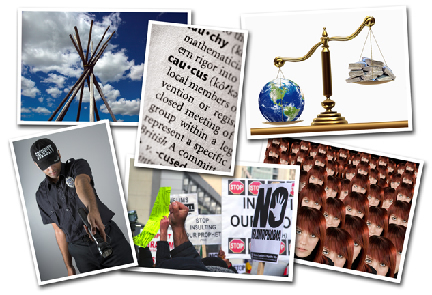
Sir Francis Bacon
James VanHise
Herbert Marcuse
Although we in Canada as well as the people of the United States and most of Europe have accepted liberal democracy as the most acceptable form of government, there are other ideas.
|
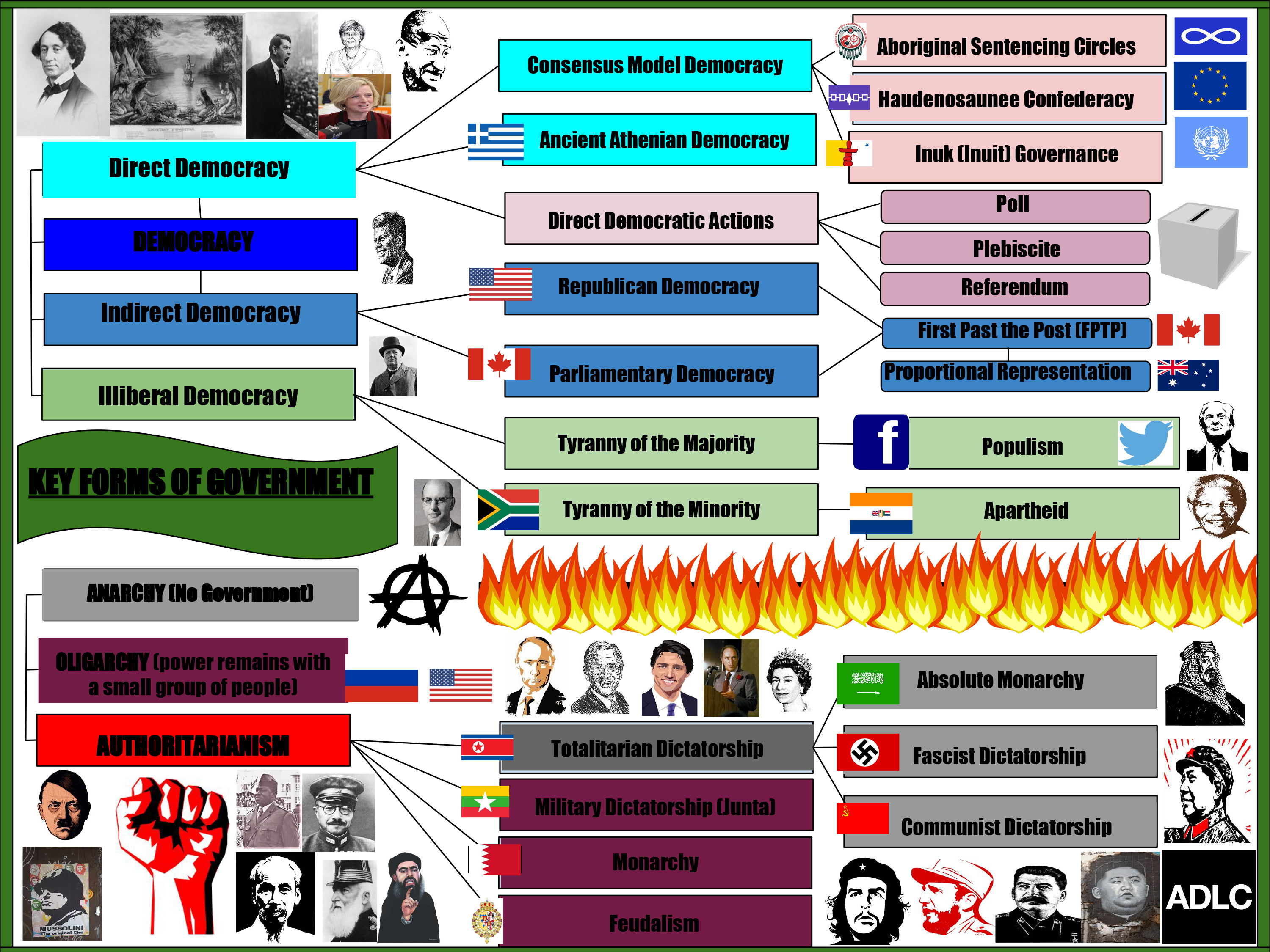
4. Historical Perspectives
With permission of Ron Jacobs, first appeared in Counterpunch
|
Stories from the past are never completely objective and unbiased. They are always told from a perspective.
- What is history?
- Who makes it?
- Who tells it?
- Why do we study it?
- What, if anything, does it teach us?
- History teaches us to understand who we are through an understanding of how we got here.
- History provides us with a base of knowledge about past societies.
- History teaches us about human nature.
- History teaches us how to think
- History teaches us the importance of effective communication. How many disasters could have been prevented if people had listened to one another?
- History stimulates our curiosity.
- History teaches us to learn from the past.
- History teaches us to make order out of chaos.
- History teaches us how to be good citizens.
- History shows us that we are a small part of a bigger whole.
|
History is the only laboratory we have in which to test the consequences of thought.
Etienne Gibson |
When people in North America and Europe look at power and decision making, they tend to view it from the point of view of the dominant culture, or as a quote often attributed to Winston Churchill goes "History is told by the victors."
But when the victors tell the story, what is missing? Are there other, equally viable, perspectives?
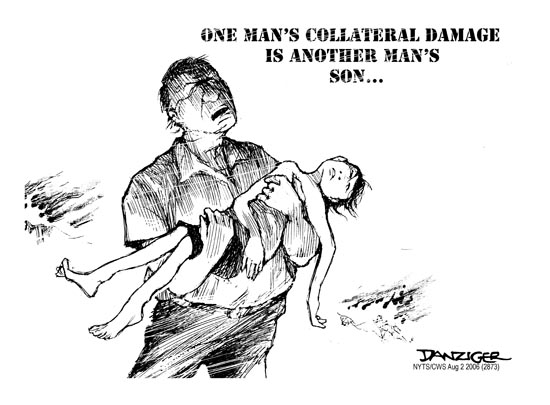
"Collateral damage" is a term originally used by the United States military to describe damage that is unintended.
What is the cartoonist saying about "perspective"?
There are many ways to learn about history. One way of uncovering what happened in the past is to look at primary source documents, which can take many forms. Primary source documents can include journals, letters, official government reports, speeches, paintings, cartoons, photographs and video or audio recordings.
Every document was composed for a reason. That purpose must be considered. When you look at the cartoon above, what reasons might the cartoonist have for creating it? Who is his audience? What is his perspective? Are their other points of view?
Kurt Vonnegut
5. Power and Decision Making in Aboriginal Socities
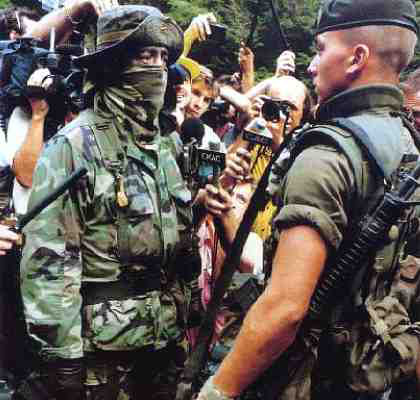
The fundamental values of Aboriginal people continue to be at odds with aspects of liberalism including its focus on the individual, competition, private property, and economic freedom that form the basis of the political and economic institutions of countries such as Canada, the US, Australia, and New Zealand. First Nations people and the European settlers who began to arrive in the 1600s had conflicting ideologies.
The image shows a stand-off between Canadian soldiers and a Mohawk warrior during a land claims dispute in Ontario. Unresolved issues between national governments and First Nations groups continue to cause conflict in Canada today
- To what extent are the issues facing Canada's Aboriginal people a result of conflicting ideologies?
- Can the will of the people be reflected through other means than liberal democracy?
- How successful was the imposition of liberalism on Canada's Aboriginal people?
"Conflicting Land Holding Ideologies" - pages 307 to 308
"Attempts at Assimilation" - pages 308 to 309
"Indian Act" - pages 309 to 310
"White Paper" - page 310
"Taking a Stand against Assimilation: Red Paper" - page 311
"Contemporary Solutions" - page 312
"Royal Commission" - pages 313 to 314
|
|
6. Imposition of Liberalism
What does to "impose" liberalism mean?
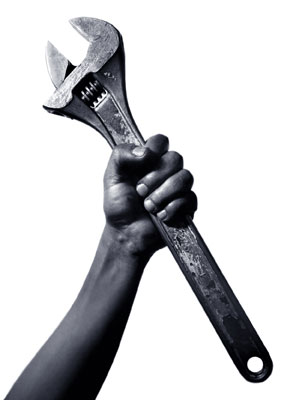
Consider the principles of liberalism again. How can any of them be forced on people against their will? Think about democracy and capitalism along with:
- Private Property
- Rule of Law
- Individual Rights and Freedoms
- Competition
- Economic Freedom
- Self-Interest
Liberalism has been imposed on people when religious beliefs establish different rights and freedoms for men and women.
Liberalism was also imposed on former communist nations that have valued collective responsibility and economic equality by imposing individual responsibility and private ownership.
Liberalism might be imposed of several reasons, and today's world has many examples of liberal societies imposing their ideology on others.

Recent events in Afghanistan and Iraq provide two examples of the imposition of liberalism.
Afghanistan
Afghanistan has been a disputed territory for generations. An autonomous territory until the British attempted to take it over during the 1800s, it became a monarchy for much of the 20th century. This time was marked by assassinations until a bloodless coup resulted in a short-lived republic. A proxy war by the United States and the Soviet Union raged from 1979 to 1989 when an estimated 600 000 to 2 million people were killed and 5 million became refugees. The military action of the two superpowers left thousands of weapons in the hands of the Mujahideen or "freedom fighters".
Afghanistan under the Taliban
From 1996 to 2001, Afghanistan was ruled by the Taliban, an Sunni Islamic political group. Although the Taliban had its political roots in the system of tribal councils in which decisions were made by consensus, in reality the Taliban is ruled by
Mullah Omar, a religious leader who has the power to make all decisions with little or no input from anyone else. Under the Taliban, Afghanistan followed Sharia law as outlined in the Islamic sacred text, the Qu'ran.
Under the Taliban, a woman could not leave her home without a male supervisor, female children could not attend school, and historic religious monuments were destroyed. Images were banned, including diagrams in medical texts and lectures. As reported in the New York Times, the following were banned: "pork, pig, pig oil, anything made from human hair, satellite dishes, cinematography, and equipment that produces the joy of music, pool tables, chess, masks, alcohol, tapes, computers, VCRs, television, anything that propagates sex and is full of music, wine, lobster, nail polish, firecrackers, statues, sewing catalogs, pictures, Christmas cards."
Another Islamic fundamentalist group, Al Qaeda, and its leader Osama Bin Laden, moved into the safe haven of Afghanistan, calling it the only true Islamic state. From their base in Afghanistan, they planned and carried out many terrorist attacks around the globe, including the 2001 attacks (9/11) on the World Trade Centre in New York and the Pentagon in Washington, D.C.
Operation Enduring Freedom
The military operation called Operation Enduring Freedom was deployed by the United States, Great Britain, and coalition forces that entered Afghanistan in response to the attack on the World Trade Centre. This was done under Article 5 of the North Atlantic Treaty Organization (NATO). Claiming that their own security was at risk, in October 2001 the NATO military forces deposed the Taliban and attempted to stabilize the country for liberal democracy. This type of government was foreign to Afghanistan, and for different reasons, rejected by many individuals and organizations. The Taliban still has a great deal of power and continues to try to regain control of the nation with leadership based on Islamic principles.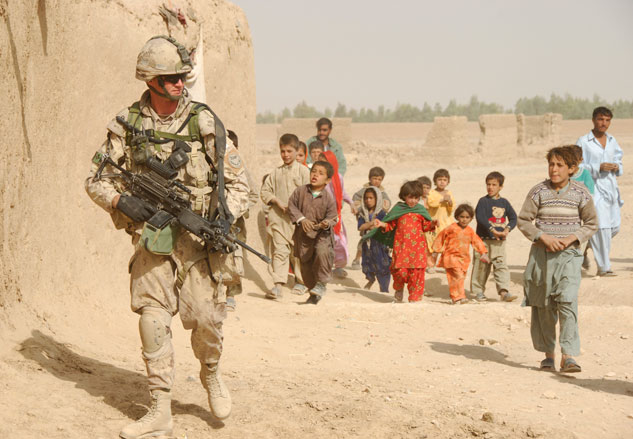
Soldier with Afghan Children 2008
- Read "Canada's Involvement in Afghanistan" on page 323 of your text Perspectives on Ideology.
- Veterans Canada: History of Canadian Armed Forces in Afghanistan
- The Canadian Armed Forces Legacy in Afghanistan
- Update on Canada's Involvement in Afghanistan today.
Human casualties
Estimates of the casualties resulting from this war are difficult to determine. The initial attack killed thousands of civilians and Taliban, and the continued fighting has led to many more deaths. Estimates of civilian causalities from 2001 to 2010 ranged from 6000 to 30 000 deaths-most from Taliban roadside bombs and suicide bombs and hundreds more from coalition airstrikes. By early 2010, more than 1700 soldiers from coalition forces had died.The Invasion of Iraq in 2003
From 1968 to 2003, Iraq was ruled by the Ba'ath Socialist Party. Although other political parties were allowed to operate, the system was set up so that the Ba'ath Party was the only one that could really hold power. Under Saddam Hussein, who
became president in late 1970, Iraq was committed to socialism, the restoration of pride in Iraq's past, the unification of Arab states in the Middle East, and the development of a secular society in which women had equal rights. Hussein was also
a dictator. His army invaded Kuwait in the Gulf War of 1990, an invasion denounced by the United Nations. They were driven out quickly by a US-led coalition. Shortly after Operation Enduring Freedom began in Afghanistan, the United States began
to challenge the legitimacy of the leadership of Iraq.
Operation Iraqi Freedom
Based on their unsubstantiated belief that Iraq was building weapons of mass destruction, the United States, Great Britain, and some allies invaded Iraq. Claiming that the people of Iraq desired freedom from the oppression of a brutal dictator, the coalition eventually captured President Saddam Hussein who was later executed by the new democratic government of Iraq.The invasion of Iraq not only brought an end to its political system; it also destroyed the nation's infrastructure and destabilized its economy. From 2003 until 2010, more than 100 000 civilians were killed with some estimates ranging as high as one million. The Iraqi government estimates that by 2010, Iraq has at least five million orphans in Iraq-more than half the children in that country.
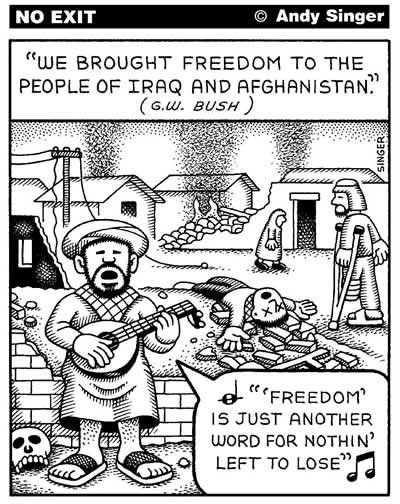
In both cases, it can be argued that "liberalism" was imposed by an outside force. Although U.S. Vice-President Dick Cheney at the time stated that the US forces would be greeted as liberators and that the war with Iraq would be short,this remains a highly controversial debate. It may be true that many citizens in each of these nations were oppressed and desired a change of government, but neither of these nations requested military intervention. Both countries were devastated by military operations and continue to face challenges to their leadership.
- Does the imposition of liberalism reflect the will of the people?
- If so, which people? Can the imposition of liberalism be justified?
- Should liberal democracies violate liberal principles to promote liberalism abroad? And if so, in what circumstances?
Try to find any of the following Iraqi films:
- "Iraq in Fragments"
- "Abadan lam nofarekoh" ("Iraq, We Never Parted")
- "Voices of Iraq"
- "In the Shadow of the Palms", the Canadian documentary
- "Zero Dark Thirty" (Rated R)
- How much should the "liberty" of a country cost in terms of human life?
- Do you believe in the old saying "Give me liberty or give me death"?
- Do you agree with the cartoonist above, who suggests that the freedom obtained by the people of Afghanistan and Iraq really means the freedom to have nothing, not even security?
7. Failures of Liberalism
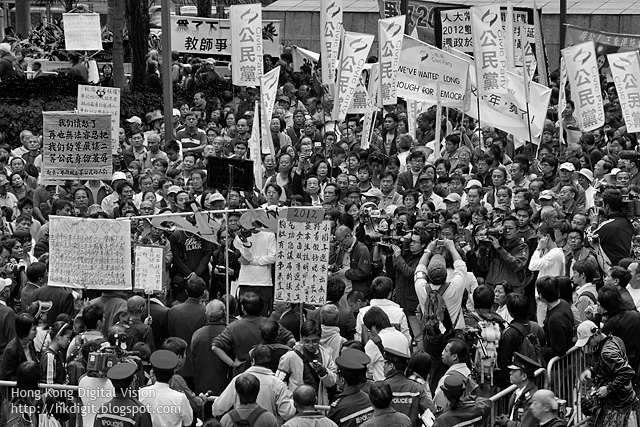
The protesters in the photograph are citizens of Hong Kong demanding that liberal democracy be maintained in their country.
Hong Kong is now part of the People's Republic of China, but from the late 19th century until 1997, it was a colony of Great Britain. During the time of British colonialism, Hong Kong developed laws, universal suffrage, and a capitalist economy patterned after Britain. During this time, it became an economic powerhouse and the people appreciated the rights and freedoms of a liberal democracy.
However, the people of Hong Kong are primarily Chinese. Great Britain's "99-year lease" of Hong Kong (and about 50 years of economic interest before that) ended in 1997. China re-gained sovereignty over Hong Kong July 1, 1997. Communist China agreed to allow Hong Kong to retain its laws and autonomy for at least fifty years after the transfer.
Today, although Hong Kong is still a democracy with one of the highest levels of economic freedom in the world, many fear that their liberal democracy will be dismantled by the People's Republic of China whose political system limits individual rights and freedoms both economically and politically.
Imposing Political Systems in the Past
During the Age of Imperialism, the world's great imperial powers imposed their political and economic systems on people all over the world because they believed their own ways were superior to those of the people they conquered. As you learned in Social Studies 10-1 or 10-2, this led to great problems. After World War II, the nations of the world agreed that no nation should have its sovereignty taken away by another nation. All countries should practise self-determination, or the right to control its own destiny. Today, powerful nations continue to insist that others adopt the values, principles, and ideologies that they consider superior.- Is democratic liberalism the best political and economic system for all people at all times?
- Or is the imposition of liberalism by the powerful liberal nations of the world just another form of ethnocentrism ?
- How would the people of Hong Kong answer that question?
Challenges of Liberalism
Although liberalism may seem the best ideology to many people, it is not without challenges.- Your look at Indigenous societies and their collectivist values showed you that many cultures do not believe that individual self-interest is more important than the common interest.
- Your exploration of the rise of communism in the former Soviet Union showed that liberalism fails when it is not extended to all.
- The failure of the Weimar Republic immediately before the rise of the Nazi Party in pre-World War I Germany showed that liberalism may not succeed when people are poor or unemployed.
- The rise of social programs in United States and Canada during the Great Depression indicates that a greater degree of collective interest and responsibility may be a more effective way of dealing with an economic crisis than economic freedom.
What ideas are presented about the viability of liberalism?
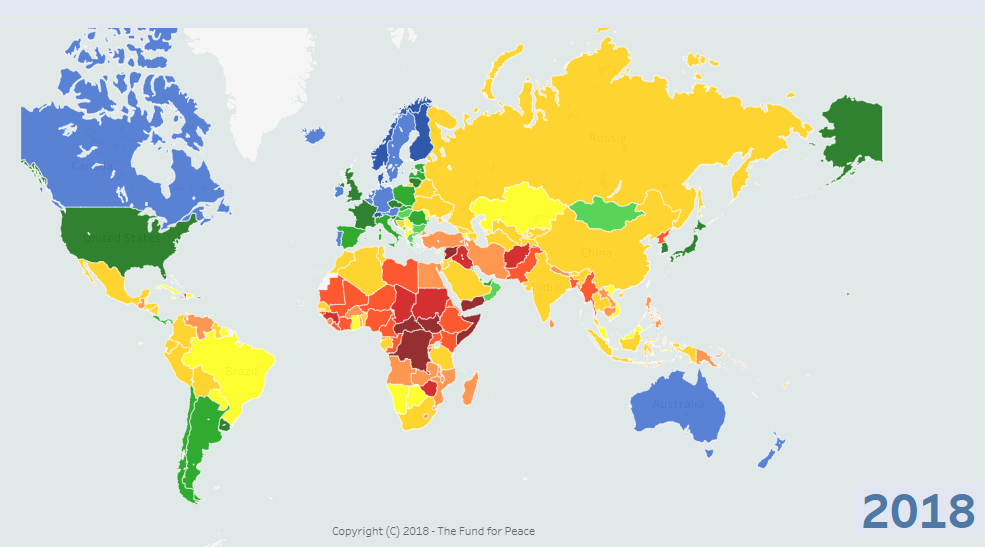
Nations are ranked from most to least peaceful:
Blue means 'Sustainable'
Green is 'Stable'
Yellow means 'Potential warning' signs
Orange means 'Possible Alert'
Red means 'Alert' failed state!
Failed States
When liberalism or an identifiable ideology fails and no other political system emerges to replace it, the result is a failed state.A failed state is a nation that is unable to meet its people's needs economically, politically, and socially. Its government does not represent the will of the people and is unable to control its own territory. Corruption is rampant and security forces are unable to protect the people. Rule of law is limited or does not exist. People may be denied both positive and negative freedoms. The nation is in economic decline.
United States and much of Europe are considered to be in moderate danger of becoming failed states. Why? What does the map show you, if anything, about the viability of liberalism?
8. Liberal Democratic Systems

If you follow election news in Canada, United States, and elsewhere, you may have wondered about some of the differences between various liberal democracies.
In this section, you will explore the main political systems that are based on the principles of liberalism, looking at the challenges inherent in the systems and evaluating how and why these systems are not always liberal in practice.
Watch this brief introduction to different political systems and democracy.
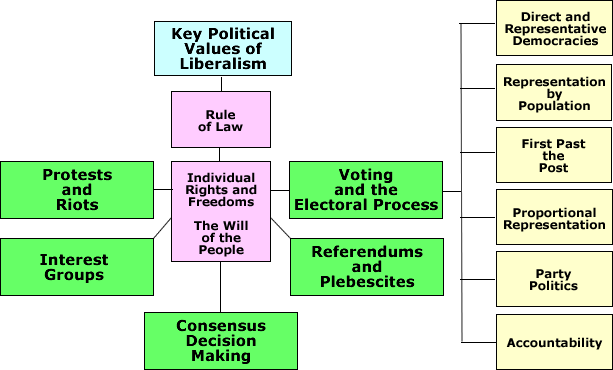
- What are the characteristics of a liberal democracy?
- How do different political systems attempt to serve the will of the people?
- What distorts or prevents the will of the people from being served?
- Why are liberal democracies sometimes less than liberal in their practices?
|
|
|
|
|
|
9. The Will of the People
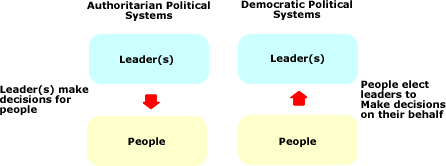
Democracy, as a political system, was first practiced in Ancient Greece.
The people of Athens, Greece formed the term demokratia from demos meaning "the people" and kratia meaning "authority".
Democracy is a form of liberal government where the citizens of a society are the foundation for all political decisions.

Ultimately, a democratic system is based on fundamental principles of liberalism, including:
- individual rights and freedoms for all
- laws that apply to all and that must be obeyed
- an economy based on the ownership of private property in which people and corporations compete freely in self-interest
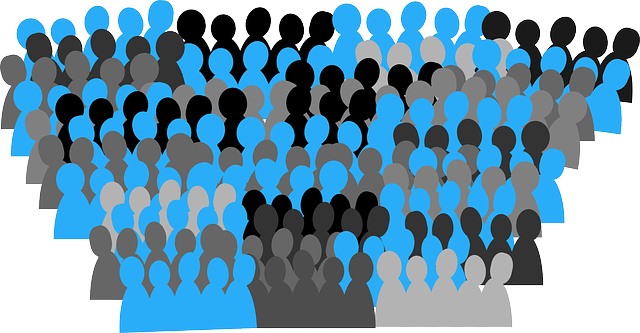
There are two main forms of democracy:
- Direct Democracy is a system in which people vote directly in person on policies and practices. It is not common in today's world as large populations cannot show up and vote on every issue.
- Representative
Democracy is a system of government in which people choose leaders to act in their interests. Most democratic nations have some form of representative democracy.
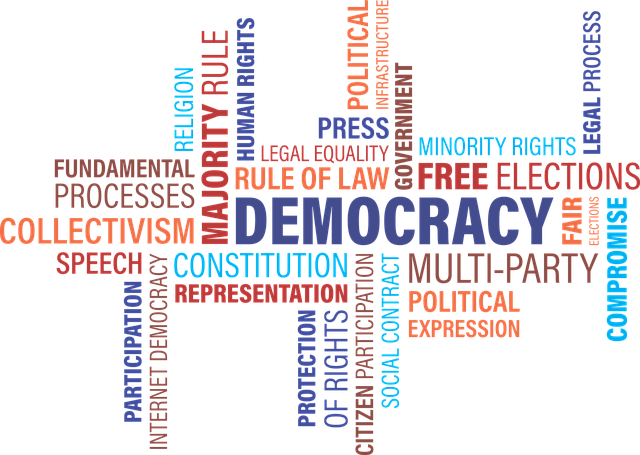
Democracy...
- means limiting the majority's will through the rule of law (and constitutional protection of minorities).
- does not always benefit everyone equally. Sometimes the majority decides to implement policies members of minorities do not like (tyranny of the majority)
- sometimes forces the majority to accept minority demands when these reflect the goals and values of the society at large (tyranny of minority), or to provide equal treatment under the law.
- does not result in total freedom to do whatever one wants. The rule of law must be obeyed.
A constitution is a formal document written either when the country was formed, when it became a democracy, or at any later date in the history of the nation. These 'rule-books' are very difficult to change as they are meant to be the guiding direction of a country's beliefs, values and laws. Additionally, it prevents any one elected representative from radically changing the rules to suit their interests or ideology.
Some countries do not have formal constitutional documents, but they use customs (tradition) to determine how government should act. Such a constitution exists in Britain. Other countries rely on an entirely written set of rules to guide political decision-making, like in the United States. Canada has a blended constitution; some rules are not written down but followed from British tradition, while we also have the Canadian Charter of Rights and Freedoms.
Constitutions may or may not be followed in practice; however, most democratic systems have systems by which the government is made accountable to the underlying values and the specific goals and practices outlined in the constitution. How? The judicial branch is responsible for ensuring that the laws and actions of government do not overstep their boundaries as set out in the constitution. Ultimately, dividing power among different branches of government ensures that everyone is equally treated under the law.

- Is a democratic system of government the best system to ensure the will of the people is addressed?
- Should democratically elected governments lead the people, or follow the people's lead?
10. Direct and Representative Democracies
Remember that in Athens, voter eligibility was limited. Women, slaves, immigrants, and people who did not own land were not able to vote. The question becomes, how is the will of the majority served if certain segments of society cannot vote?
This is a major difference between classical liberal societies of the 19th Century with those in the 19th Century. The expansion of suffrage is reflective of a modern liberal society.
Representative Democracy
There are different ways to vote for representatives in a democracy. Watch this brief introduction below: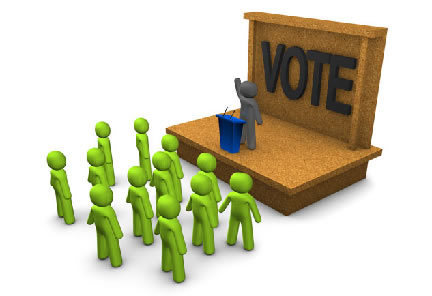
Direct Democracy in Canada
Canada has a population of more than 33 million people. Direct democracy would be very difficult to implement here. Providing a venue would be impossible for millions of people to express their opinions, consider all the opinions of others, debate suggested policies, and then hold a vote on which policy to follow.Canada is a large and complex nation. Many issues need to be dealt with. Laws must be written carefully in much detail. One bill can be many pages long and deal with subject matter unfamiliar to many individuals. Most people in Canada, as many ancient Athenians, could not, or would not, spend the time to review all proposed laws.
Direct democracy is used only in rare instances in Canada. If elected politicians see an issue as so important that they wish the electorate to have a direct role in decision-making, they may choose to hold a referendum or plebiscite. Referenda and plebiscites may be binding or non-binding. In a binding referendum, politicians must implement the decision reached by the direct vote. A non-binding plebiscite is held to provide politicians with a sense of the people's opinion on an issue, but the politicians are not required to follow through with what the people decide.
Plebiscites and referenda are two tools of direct democracy, and tend to be used more frequently at local levels of government. Citizens may be asked to vote on a local issue at the same time as they elect their city councillors. In Canada, national referenda are far more infrequent than at the local or provincial levels. Only three national referenda have been held in Canada since confederation.
However, some populous parts of the world continue to practise direct democracy. For example, the state of California has an extensive system in which citizens vote on multiple propositions or proposed laws. In this case, the will of the majority makes or breaks the proposed law.
Holding a referendum on the Charlottetown Accord was expensive and divisive. Many Quebeckers saw the result as a rejection of Québec's distinctiveness within Canada. In 1995, Québec held its own referendum on whether the province should remain in Canada or become a sovereign nation. By the narrowest of margins, Quebeckers chose to remain part of Canada.
As you have discovered, the understanding of who should have the right to vote and run for political office in Canada has broadened considerably over time. Canadians can now have a much more representative democracy than existed in ancient Athens. Canada still has some problems that plagued ancient Greek democracy, but Canada's are much larger.
However, some populous parts of the world do practise direct democracy. California has a system in which citizens vote on propositions or proposed laws.
In 1978, Californian voters rejected tax increases. By voting for Proposition 13, they chose to cap property tax rates, reducing them by an average of 57%. At the same time, they established a requirement that all taxes, including property tax and income tax, could not be increased unless the action received a two-thirds majority approval in the legislature. This has had disastrous effects on public schools, libraries, fire departments, post-secondary institutions, and other government-funded services. Cost of goods and services are always increasing, and more people are moving to California; its government needs tax dollars to operate. As a result, the Government of California now is in a budget crisis, without the ability to tax its citizens at sufficiently high rates to fund essential services. This has resulted in some interesting actions, such as the early release of prisoners from jail, mandatory days off without pay for state workers, massive teacher layoffs, and reduced services to people with disabilities.
In 2000 and 2008, the voters of California decided to describe a marriage as "a personal relation arising out of a civil contract between a man and a woman" although California law describes a marriage as "a personal relation arising out of a civil contract to which consent of the parties making that contract is necessary". In this case, California law and the will of California voters conflict. Which one actually reflects the will of the people?
- What are the advantages and disadvantages of direct democracy in terms of serving the will of the people?
- In direct or representative, how can the "tyranny of the majority" infringe on the rights of the minority?
11. Canada's Parliamentary Democracy
Responsibility goes two ways. As voters, you are responsible for participating in your democracy, and the elected officials are responsible to and for the people who elect them. In Canada, the Prime Minister and his/her cabinet are chosen from the elected House of Commons.
Based on the British parliamentary tradition, Canada is also a constitutional monarchy. Therefore, the executive branch, is made up of a Head of State, who is the Governor General, and the Head of Government, who is the Prime Minister. They each have different responsibilities in our democratic system.
Understanding exactly how representative democracy works is important. As a citizen, you should understand how your government is chosen. Ultimately, each electoral system has strengths and weaknesses in terms of truly representing the will of the people. Let's examine Canada's in more detail.
The Head of State in Canada is the Governor General. Because Canada is a constitutional monarchy, the monarch is the country's head of state. Because the British Queen cannot open Canada's Senate or sign every bill into law, she has a representative, which is the Governor General. This person is appointed by the Queen, usually on the request of the Prime Minister and they usually serve 6 years.
The Head of Government must be elected to the legislative branch. This is the Prime Minister. The Prime Minister selects the cabinet ministers (department heads for ministries) from the pool of elected Members of Parliament that sit in the House of Commons. They are directly responsible and must answer to the other elected Members of Parliament. As a result, the executive branch is embedded into the legislative branch in Canada, thus leading to the phrase 'responsible government'.
In republican presidential democracies, these two roles are combined into the President, who is not part of the legislative branch and is not accountable to them in the same way.
The Senate
Canada's Upper House is a custom or tradition passed down from British parliamentary democracy. Based on classical conservative notion of tradition and elitism, it was based on the British House of Lords, believing that the 'masses' or the common people in the lower House of Commons needed a check or oversight regarding their proposed legislation. While this notion has changed over time, Canada's Senate remains appointed by the Head of State, the Governor General. Today, the Prime Minister selects citizens to be Senators who are then sworn in by the Governor General. Senators are not re-elected, but rather serve until the age of 75 years.In theory, because the Senate is not elected, they can provide institutional memory (history) as well as independent criticism of any bills being put forth by the House of Commons. Additionally, they are selected to provide equal representation across all geographic regions in Canada. Due to the great population disparity across the country; this house provides an opportunity to limit tyranny of the majority in the House of Commons.
All legislation from the elected House of Commons must also be debated and passed in the Senate. There are limits to their power thought. While they can strike down or fail to pass a bill (proposed law), they cannot alter any bills that deal with the 'power of the purse' or the people's money. This has to do with the fact that they are not directly accountable to the voters.
Please note the numbers below add up to 24 seats for each 'region' of Canada. This is to balance that 40% of Canada's population reside in Quebec and Ontario.
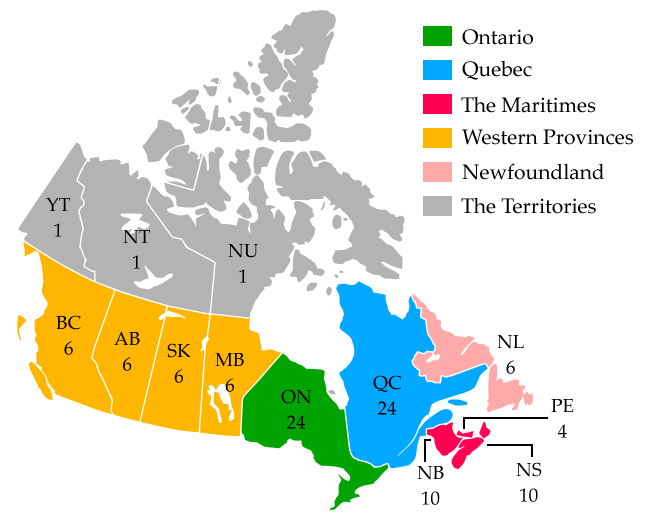
House of Commons
The House of Commons is considered the Lower Branch of Canada's Parliament. This is who we elect when there are Federal (national) elections. To determine our Prime Minister and his/her cabinet ministers, all politicians must be elected to the House of Commons (legislative branch) first.The political party that wins the most riding elections, which translates directly to seats in the House of Commons, gets to be the governing party. This means their party leader becomes Prime Minister. The Prime Minister then selects his/her cabinet ministers who will run government departments. Each of these ministers must also be elected to the House of Commons. This ensures direct accountability of the executive branch inside the legislative branch.
The same cannot be said in a presidential republican democracy, as the President is voted for separately from the legislative branch, and his/her cabinet are not elected by the people, but chosen by the President. This will be covered later on in the unit.
On election day, individual citizens, based on their own self-interest, vote in a secret ballot for the party that they feel can best represent them. Whom ever receives the most the ballots or votes in each riding, becomes the MP or 'winner' to represent all of the constituents or people that live in that district. Each riding gets one of the 338 seats in the House of Commons.
The winner of each riding is then tallied up or counted, to see which political party won the most seats out of the 338.
|
What do you notice about the number of ridings across Canada?
Remember, the geographic ridings are created around 100,000 people (approximately).
How well does it reflect the will of the people?
- How could each of these features in a representative democracy help to ensure that those who are elected remain true to the will of the people?
12. Presedential Rebpulican Democracy
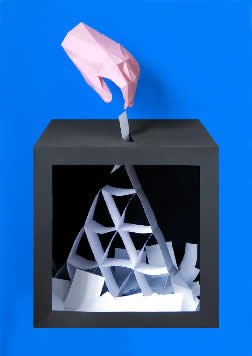
Republican Democracy
The United States has a different form of democracy than Canada has. The US system is called republican democracy.Similar to Canada, the United States generally uses the first-past-the-post system to determine which candidate becomes the people's representative. However, unlike Canada, U.S. politics is ominated by only two political parties, the Republicans and the Democrats. Although independent candidates may still run for election, they seldom capture significant shares of the vote. This means that, unlike in Canada, winning candidates also typically have the majority of votes cast in their favour; votes are not split among several opposing candidates. Generally, winning candidates in the US represent the majority of all voters.
Choosing the President - the Electoral College
In Canada, the head of state is the leader of the political party with the most seats in the House of Common. Voters in the United States choose their leader through the Electoral College system. Under this system, all voters cast ballots for their choice for president in state presidential elections. The presidential candidate who gets the most votes is said to have won the popular vote. However, these results are not used directly to determine who will win the presidential election. Instead, the popular vote is used to inform a second vote-one by a select group of electors known as the Electoral College.Each state is assigned a number of electors based on the number of representatives it has in the legislative branch of the federal government. These electors form the Electoral College for the state. These individuals are the people who cast the votes that decide which presidential candidate becomes the president.
Usually the members of the Electoral College do not vote based on their own personal beliefs. Instead, they are expected to cast their votes based on which candidate won the popular vote in the presidential election in their state. Ultimately, members of the Electoral College are expected to exercise the will of the people.
The Electoral College Explained: Is it more reflective of the will of the people than Canada's electoral system?
Problems with the Electoral System
In the 2000 Presidential election, candidate George W. Bush won 271 electoral votes with 47.9% of the popular vote while Al Gore obtained 266 electoral votes but 48.4% of the popular vote. Because he won the most electoral votes, Bush won the election. However, the majority of voters selected Gore.In this case, was the will of the people reflected in the results?
- Which of the two political systems best reflects the principles of liberalism?
- Which one seems to most accurately reflect the will of the people?
13. Proportional Representation
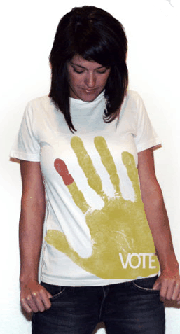
Proportional Representation
A system of proportional representation involves candidates from more than two political parties. One is chosen based on his or her share of the popular vote. In proportional representation, political parties are represented in proportion to the amount of votes cast.The Canadian and US systems do not use a system of proportional representation. They use what is called " first-past-the-post"—whoever gets the most votes wins. For example, imagine you wanted to elect four candidates and you had three political parties with 100 votes cast. You have a list of candidates, each affiliated with a political party.
| Party A |
Party B |
Party C |
|---|---|---|
| 50 votes |
25 votes |
25 votes |
Under the plurality or "first-past-the-post" system, Party A would get all the seats. Under proportional representation, Party A would get 2 seats and Parties B and C would get one seat each. In this manner, the minority parties and the people who vote for them are represented in government. In our present system in Canada, those who voted for the smaller parties would not be represented at all.
In the 2019 Canadian federal election, although 1.2 million people voted for the Green Party, it elected only three MPs. By contrast, 1.4 million Bloc Québécois voters in Quebec elected 32 MPs. The Conservative Party received the most votes (6.2 million), but the Liberals, who received 6.0 million votes, won the most seats.
In both Canada and the United States, a movement is occurring to begin to use proportional representation because significant numbers of voters do not feel represented in parliament. Many feel this lack of true representation is a cause of the low voter turn-out in most Canadian and provincial elections.
- Does proportional representation accurately reflect the will of the people?
14. Influences and Challenges to Decision Making
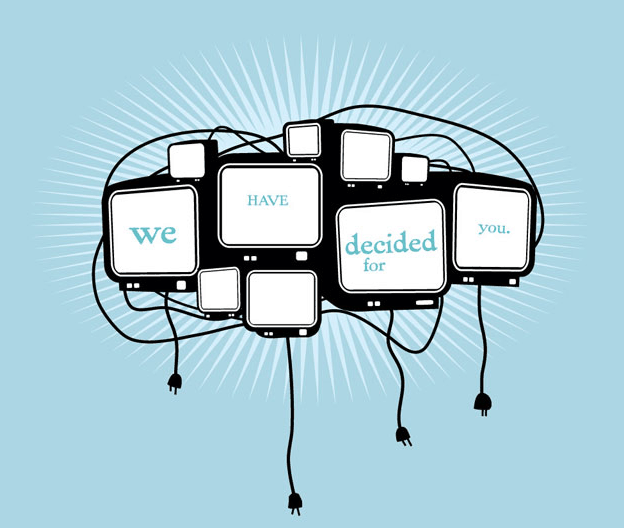
Many forces influence decision-making
Some forces influence the voters themselves, encouraging them to elect representatives, and others influence those who were elected.The Media
Powerful influences over people's lives, most television networks, large newspapers, magazines, and popular websites are owned by powerful people and corporations with their own interests and goals. News stories on TV and newspapers can be biased towards a particular political agenda.Political Campaigns
When candidates run for office, they encourage voters to support them through election campaigns. Candidates use the media to get their messages across. Their media campaigns provide voters with ideas of what the candidates stand for and what kind of people each is. Candidates and political parties can also run negative campaigns, filled with attacks on their opponents' personal lives and past actions in or out of government.Influence of the Rich
To run for office is expensive, so most people cannot afford to run without the support of wealthy individuals, political parties, corporations, and special interest groups. In most democracies, individuals and corporations can and do donate significant amounts of money to political parties for their election campaign. As well, those without independent income may not be able to run for office, which limits the ability of the common man to participate fully in democracy.Campaign Spending in the United States
Americans running for president can use the power of their political parties to raise funds to support their campaigns, especially from individuals. In the 2016 United States Federal election, Donald Trump raised US$350 million to fund his campaign. His opponent Hillary Clinton raised US$586 million. Details of campaign financing are available at the Federal Election Commission website.Limits to Spending in Canada
There are limits to how much an individual, corporation, or trade union can donate to a political party and to a federal campaign, based on the number of voters in the ridings in which the party runs candidates. Lobby groups can spend no more than $150 000 nationally or $3000 in any one riding.Corruption
If special interest groups and campaign donors receive preferential treatment, corruption occurs. A strong opposition, access to information, and a free press may prevent corruption.Lobby Groups
Special interest groups that work to influence government to act are called lobby groups. They work with elected officials and government employees to get them to introduce and vote for legislation that supports their goals.In Canada, lobbyists are required to register with the government, and the names of all lobby groups are available to the public. For example, tobacco companies lobby the government to protect "smokers' rights" to encourage smoking and keep cigarette sales high. Anti-smoking groups lobby for bans on smoking. Lobbyists can sit on either side of an issue. For example, in the abortion debate, organizations support either the right to life or the right of a woman to choose. All must register with the government if they intend to act to influence government decision-making.
Go to the website of the Office of the Commissioner of Lobbying of Canada and search for lobbyists by keyword. Go to this site and type "tobacco" or "right to life" and see what comes up!
Election Costs
Elections cost money, so taxpayers may not support frequent elections that may give them better opportunities to let their opinions be known.Voter Apathy
Particularly among younger voters, voter apathy is serious. The charts on the textbook pages indicate a steady decline in youth voting. Why? Some nations, such as Australia, make voting mandatory. However, in a system based on individual freedoms should decision-making be enforced?In the 2015 election, 57% of young voters (age 18-24) participated. This was the highest it had been in many years, and more than twice what it had been in the 2000 election. However, young voters were still the least likely group to participate in the election. (Source: Elections Canada)
"Voter Turnout" on page 347
"Lobbying by Interest Groups" pages 350 to 351
- How do our political systems in North America reflect the will of the people?
|
15. QUIZ 5.1: POLITICAL SYSTEMS
- Go to the unit tab
- Click on the quiz
- Attempt the quiz
- Feel self-assured that you can succeed in this course
16. Intro to Authoritarian Systems
Liberal democracy is a relatively new political system in world history. Before democracy, most nations had authoritarian governments, absolute monarchs, who were unelected, unaccountable, and not necessarily acting in the best interests of the people.
When democracy first began in Europe, it caused great unrest. The change in the status quo and the violence that accompanied the French and American Revolutions were of great concern to many people. As people began to experience more freedom, there was also a loss of collective security. Although we know now that was a temporary condition, we can also understand the problems that the democratic revolution created in these societies.
Authoritarianism Today
Most people living in the Western world believe that liberal democracy is the best political system to meet the needs of all people.However, millions live in non-democratic states. These countries might be former communist states moving towards democracy, former democracies taken over by powerful elites with military support, or authoritarian states incorporating some aspects of democracy. They might be nations in which many people have strong religious beliefs and support a religious figure as a ruler. Authoritarian states can have either a capitalist or a centrally-planned economy. Generally, leaders in authoritarian states control the media, restrict opposition and dissent, and are not accountable to the people.
Serving the Common Good?
In democratic systems, voters and the representatives they elect must make decisions to benefit the entire nation. Some of these decisions, such as the establishment of universal health care, the abolition of smoking in public places, and mandatory seat belt use, might be controversial because they put the common good above the rights of the individual.Many authoritarian political systems believe they operate for the common good and that the decisions they make are in the best interests of their people.
As you learned in Unit One, ideological perspectives are based on individual and collective beliefs and values. Only you can say what you believe concerning your ideological principles.
In this section, you will explore authoritarian systems and consider the extent to which they demonstrate liberal principles and values.
- Is it possible to believe in an ideology in which submission to authority is part of your belief system?
- Is it possible for individuals to trust a leader who is not accountable to their will?
- Is it possible for authoritarian political systems to be liberal in any sense?
17. Ideologies and Authoritarianism
-Khmer Rouge motto
In 1975, the Khmer Rouge took control of Cambodia. They threw out the elected government and proceeded to drive all people from the cities into the countryside where they were forced to farm and fish. Those who disagreed were killed immediately or sent to prisons where men, women, and children were tortured and then killed. Children were indoctrinated and were given leadership roles in executing dissenters.
The Khmer Rouge, an agrarian communist dictatorship in Cambodia under leader Pol Pot, believed that the people of Cambodia would be better off if they returned to their roots as an agricultural nation, became entirely self-sufficient, and revered the glorious history of the Khmer Kingdom.
Their authoritarian regime lasted from 1975 until 1979 when the Vietnamese army entered the country. The regime resulted in the deaths of 1.5 million people, 20% of the nation's population-one of the largest genocides in modern history.
The Khmer Rouge, similar to the Nazis, kept detailed records of those they imprisoned. The image is from Tuol Sleng Museum of Genocide, a former high school turned prison camp,
where more than 6000 photos of victims were left behind by the Khmer Rouge as they fled from the Vietnamese.
|
A Vision of the Future
The Khmer Rouge, like many authoritarian regimes, followed an ideology that included an idealized version of the past and a utopian vision of the future. In their vision, all citizens would live a communal lifestyle, produce their own food, clothing, and medicine, and be free from the influence of other nations. They established a regime that pitted the "new people" against the "old people"-urban against rural, educated against uninformed, those who had travelled and knew about the outside world against those who followed a traditional lifestyle. As most authoritarian regimes, the Khmer Rouge were not interested in the "will of the people" or individual rights. They believed that their actions were for the common good, and they were prepared to take the necessary steps to make their vision a reality.
|
Compare the vision of the Khmer Rouge with what you have learned about the vision of the communists of the former Soviet Union and the fascists of Nazi Germany. Although all three regimes may have believed they were acting in the best interests of their people, were they? What evidence could you use to support or refute this idea?
- Compare the vision of the Khmer Rouge with what you have learned about the vision of the communists of the former Soviet Union and the fascists of Nazi Germany. How are they similar? How do they differ?
- Although all three regimes may have believed they were acting in the best interests of their people, were they?
- What evidence could you use to support or refute this idea?
- Do authoritarian regimes act for the common good? List examples with your answer.
- Do they reflect the will of the people? If so, how? If not, do you have examples support your answer?
- How does the government use the techniques of dictatorship to maintain control?
18. Types of Authoritarianism
Authoritarianism can take many different forms. You learned in Unit Four that the Soviet Union was a totalitarian one-party state. Read the following ways an authoritarian government can operate - can you decide which one fits Nazi Germany?
Example: The only recent example is Syria, where Hafaz al Asad took power through military means in 1963. On his death, his son Bashar al Asad became "president" as the only candidate in the election.
Example: The House of Saud, led by King Saud of Saudi Arabia, is one of the few absolute monarchies today. He is part of a large and powerful family that controls the nation and its vast oil wealth.
Example: Iran became an "Islamic Republic" in 1979 after the majority voted for the people's sovereignty to be replaced by the "absolute sovereignty of God". Under the constitution of Iran, which merges elements of democracy and theocracy, the Supreme Leader of the Islamic Republic of Iran shares power with the elected president. Ali Hoseini-Khameni was selected by the Assembly of Experts, a panel of elected Islamic scholars. Although Iran has an president elected by universal suffrage, the Supreme Leader has greater powers that spring from the religious beliefs and traditions of Islam.
Example: Myanmar is a military dictatorship.
Examples: The People's Republic of China, the Democratic People's Republic of Korea today, and until recently, the Arab Socialist Ba'ath Party in Iraq under Saddam Hussein
Example: South Africa under apartheid was the wealthy white class ruling over the majority of blacks in South Africa.
19. Techniques of Authoritarianism
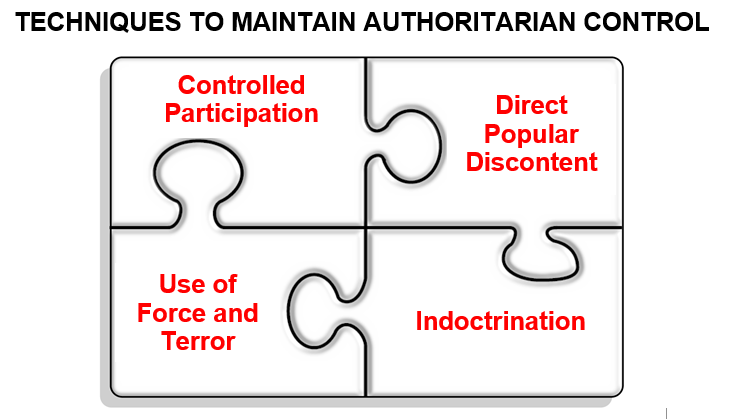
You were introduced to these four techniques of dictatorship in Unit Four when you studied Nazi Germany and the Soviet Union.
- Use of terror and force
- Use of propaganda and indoctrination
- Controlled participation in the electoral process
- Directing popular discontent towards a scapegoat
- Limits on dissent
|
Propaganda: pages 362-363
Controlled Participation: page 363
Directing Public Discontent: pages 363-364
Use of Force & Terror: page 364
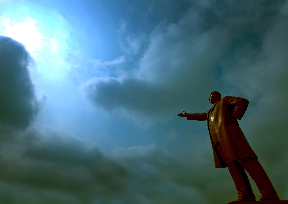
Example: North Korea
Formally known as The Democratic People's Republic of Korea, North Korea is one of the most fascinating and confusing examples of authoritarianism in the world today. This by-no-means liberal, impoverished, and highly secretive single-party state has its own unique ideology and a strong personality cult following its founder, Kim Il-sung.North Korea became an independent state in the 1950s after the Korean War. It follows an ideology of Juche or self-reliance based on the idea that "Man is the master of everything and decides everything." Developed by Kim Il-sung, the ideology is also referred to as "Kimilsungism". It includes the following:
- political independence
- economic self-reliance
- self-defense
Please watch the following video explain North Korea:
Cult of Personality
Statues to Kim Il-sung are in many prominent places, and many people travel for miles to see them, bursting into tears at the sight of the former beloved leader. He is revered to the extent that he has been named "Eternal" president, and no future
leaders may be named "president". His son, Kim Jong-il, assumed the leadership after his death and is referred to as "Great Leader" or "Supreme Leader".
|
- Do you think the government of North Korea acts in the common good of its people?
- To what extent is the will of the people reflected in their actions?
To what extent does a dictatorship reject liberalism?
|
20. Authoritarianism and Freedom Today
What does freedom mean?
Great changes have been made in political systems through both peaceful and through violent means, but many nations in the world today are not considered fully "free".
Consider the 2018 map to the left from Freedom House, an independent organization that supports the expansion of freedom around the world. Only those countries coloured green are considered to be truly free.
This map suggests that, although most of the world's territory may be ruled by liberal governments, the majority of people in the world live under restrictive regimes that allow only a limited amount of personal freedom.
Freedom House defines a free country as one in which people have political rights and civil rights. Political rights allow them to vote and elect representatives who are accountable to them. Civil rights are identified below.
Civil rights include the fundamental rights and freedoms outlined in the Universal Declaration of Human Rights adopted by the United Nations General Assembly in 1948:
- Freedom of religion
- Freedom of expression
- Freedom of assembly
- Freedom from torture
Although many authoritarian governments deny people individual rights and freedoms and often resort to brutal measures to maintain power, many do have the chief objective of providing a better life for their citizens. Authoritarian regimes are often very good at achieving their goals.
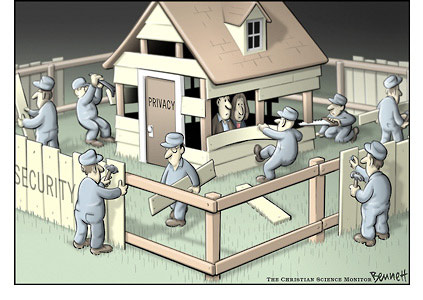
Illiberalism, Authoritarianism, and Democracy
Many nations call themselves democracies because they have free and regular elections. However, their actual practices do not support fully liberal principles. When a nation does not support liberalism, it is said to be illiberal or to practise illiberalism. All authoritarian nations can be said to be illiberal because they do not allow their leaders to be elected and they deny their citizens civil rights.Democratic nations may also practice illiberalism. A highly democratic nation such as the United States may be considered illiberal when it denies fundamental freedoms in times of crisis. The USA Patriot Act is an example. After the attack on the World Trade Center, the United States established immediately an act that broadened the powers of law enforcement to protect citizens from terrorism. Many claim this act has restricted civil liberties. The cartoon on the left by US cartoonist Clay Bennett suggests that people have been forced to give up their right to privacy to protect their security.
Liberalism in Venezuela
Other democratic nations, such as Venezuela, have regular elections in which there is strong participation. Now- deceased socialist President Hugo Chavez set price controls on food, contributed heavily to education and health care especially for the very poor, worked towards economic equality, and nationalized key industries. There have been concerns about intimidation of the press. Venezuela also has high rates of political corruption, is a centre for drug trafficking, and has one of the highest homicide rates in the world. In 2009, a referendum was held in which the majority of voters supported removing term limits for elected officials, which some believe limits liberalism.Is it possible for an authoritarian government to address the needs of its citizens?
21. Quiz 5.2: Authoritarian Systems
- Go to the unit tab
- Click on the quiz
- Attempt the quiz
- Feel self-assured that you can succeed in this course
22. Conclusion
In Unit 5, you explored the extent to which liberal values are workable in today's society as seen through various political systems. You looked at the nature of power and authority and explored the imposition of liberalism historically and in our contemporary world. You looked at various forms of democracy including systems of Canada and the United States. You considered authoritarian political systems, realizing that democracies can be less than liberal and authoritarian systems can reflect both liberal principles and the will of the people to some extent.
Through this study you should now be closer to having your own ideas about whether liberalism really works and if there is justification for liberalism being imposed on people who may have a different worldview.
Power and Decision Making
In many traditional societies, decision making has been through consensus with a view for the common good. When the first Europeans arrived in North America, they brought their beliefs in individualism with them. These beliefs conflicted with a more collectivist worldview. As more Europeans came to North America, they brought their political systems with them, ignoring the existing structures of aboriginal people. They endeavoured to impose their views on the aboriginal people, causing conflicts which are with us today.
Historically, decisions in most nations of the world were made by powerful leaders who inherited their rule. As societies became more liberal, people began to believe that real authority comes from the people in the form of democracy.
In terms of foreign policy, powerful nations of the world continue to try to impose their liberal beliefs on other nations. Iraq and Afghanistan are contemporary examples.
Challenges for Liberal Democracies
Democracy has various forms. Each presents various challenges and opportunities to reflect the will of the people. Types of democratic systems include:
- direct democracy
- responsible government as found in Canada
- republican democracy as found in the United States
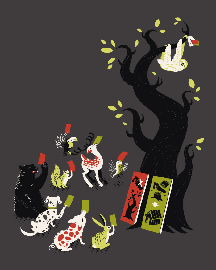

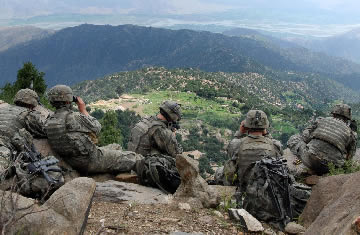
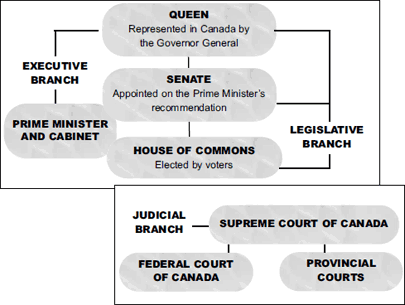
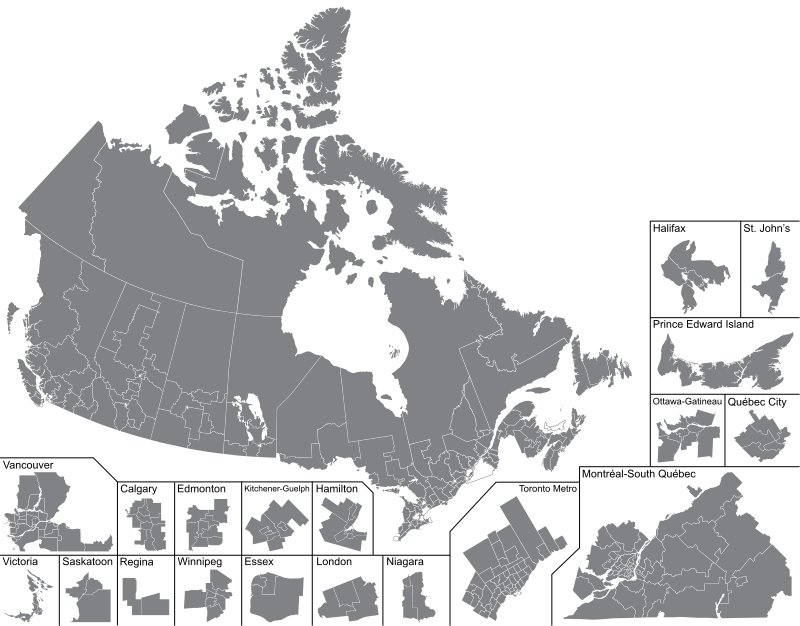
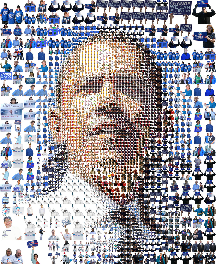
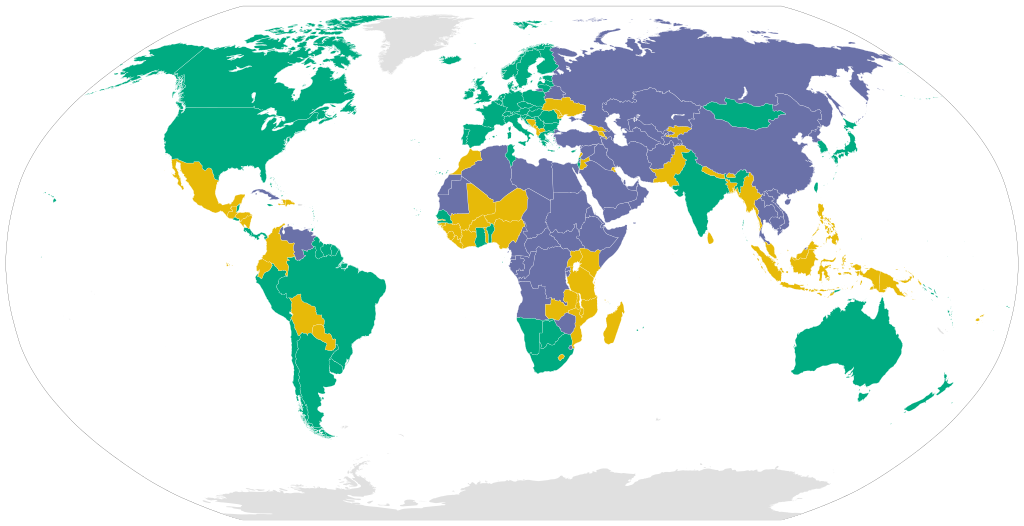 Courtesy: Freedom
House
Courtesy: Freedom
House